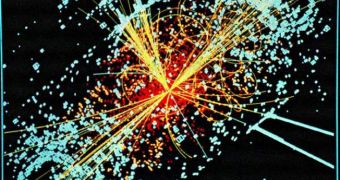Officials at the European Organization for Nuclear Research (CERN) say that the largest particle accelerator in the world is currently smashing together unprecedented numbers of atoms.
The state-of-the-art facility features the most powerful machine of this sort ever constructed, the Large Hadron Collider (LHC), which has a diameter of 27 kilometers, or 17 miles.
Its tunnels are laden with superconducting magnets, which accelerate beams of protons in opposite directions at very high energy levels, of up to 14 teraelectronvolts (TeV) total.
But, in addition to the energy level of the proton beams, the number of actual atoms in the beams is also critical to the LHC quest to find the Higgs boson, LiveScience reports.
When the particle accelerator was first ignited, back in 2008, it began operations by sending out one bunch of protons in each direction, and then watching the particles smash into each other at the main points of intersection in the accelerator, where all the detectors are located.
At this point, the LHC is generating and sending out 256 bunches of protons at the same time, which means that the total number of particles in the beams is 256 x 100,000 million protons.
Despite this impressive amount of atom cores smashed together, LHC officials say that this impressive milestone is only a stop along the way towards colliding even more protons against each other.
“We've got a long way to go. For this year, we hope to get up to 400 bunches,” explains the director of operations at the LHC, Mike Lamont, saying that a variety of methods can be used to boost collision intensities.
“At the interaction point where bunches pass through each other, we can work on the number of protons in a bunch, the number of bunches, and also the actual size of the beam at that interaction point,” Lamont explains.
“At the moment it's focused down to 60 microns – about diameter of human hair. What we can do is reduce that size even more,” he goes on to say.
A smaller beam size translates into a higher chance for protons inside the colliding streams to ram into one another, breaking apart and producing a shower of elementary particles in the process.
This happens because individual atomic cores have less room to pass by each other. In other words, the narrower the beam, the more protons slam into each other, increasing the chance of experts finding the boson they are looking for.
But LHC officials admit that, while progress is taking place, they are still a long way for producing the type of results that are expected of the massive machine.
“All the experiments are working very well – we've certainly given them a good data set this year. But to find the really interesting stuff like Higgs or supersymmetry, they're going to need a lot more data,” Lamont explains.
“Our collision rate eventually will be enormous. When we get to design, we're talking 600 million events per second,” the LHC official concludes.

 14 DAY TRIAL //
14 DAY TRIAL //